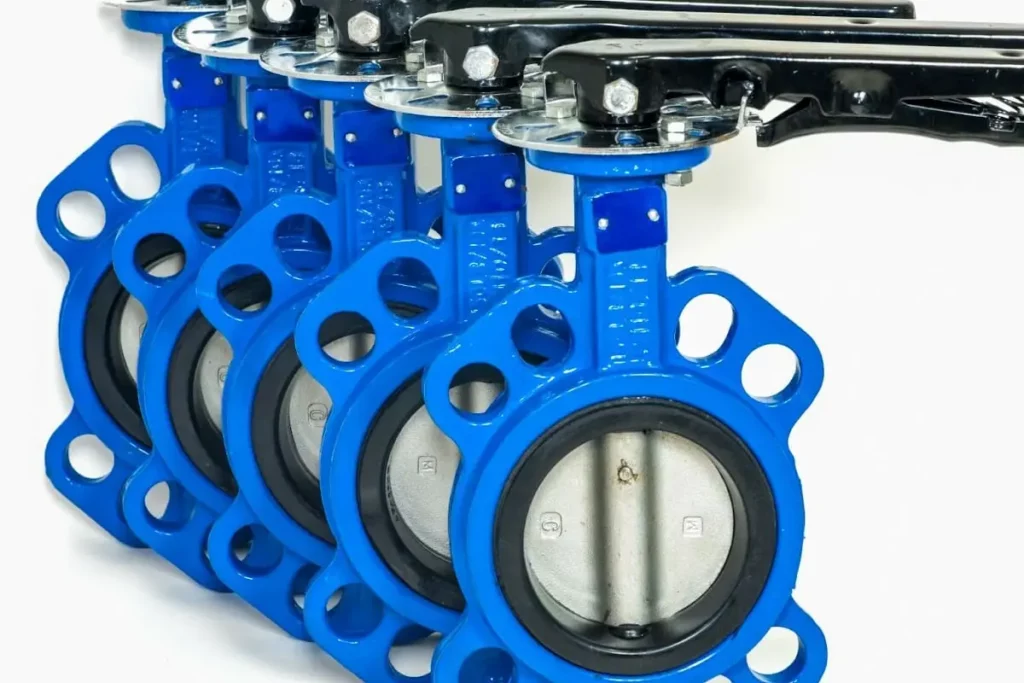Butterfly valves are used in food and beverage, hydrocarbon, mining, water and oil and gas industries. The purpose of a butterfly valve is to isolate and regulate the flow of a fluid. The closing mechanism of this valve can be compared to a ball valve that has a quick and easy shut-off.
Butterfly valves are made from various materials depending upon the application. It is called a butterfly valve because it has a thin circular disc that rotates around the central axis. The disc therefore looks like the wings of a butterfly. Now let us look at the basic types of butterfly valves and their installation.
Wafer Style Butterfly Valve
These types of valves are clamped between two adjacent flanges in the pipework. The studs pass from one flange to the other around the circumference of the valve body. Wafer style butterfly valves typically have the liner on the body extend onto the flange faces of the valve which then acts as the gasket seal against the face of the mating pipe flange.
These valves are designed so that they fit between most flanges and are less costly than the other varieties. They are also one of the most basic types of butterfly valves.
The installation process involves fitting the valve between two pipe flanges that have been installed beforehand. The holes in the flanges are aligned with the circular ‘location’ holes in the valve body.
The next step is to insert the bolts and nuts into the flange and the valve to connect the two together. An important thing to note is that you should not over tighten the flange bolting..
After installation of the valve, you should test the opening and closing to make sure that the valve freely rotates between the open and closed position.
Lug Style Butterfly Valve
The lug style butterfly valve is commonly used for end of line service.
They have so-called ‘ears’ on their body into which threaded holes are incorporated. These threaded holes are used to connect the valve to the pipe flange.
During the installation of the lug style valve into the pipeline, the flanges of both sides are installed with bolts. For end of line service, the valve only needs to be connected to the one flange.
It is important to note that the bolts of lug-type valves are of the correct length. If the bolt length is too long, the bolts from each side of the valve will contact each other within the threaded lug hole, preventing a suitable clamping pressure being applied to form a seal against the face of the pipe flanges.
Double Flanged Butterfly Valve
These valves typically are used to regulate and section the flow of water in plumbing, irrigation, and other water supply facilities.
Before installing the double flanged butterfly valve, you need to align the adjacent pipe flanges. Ensure that the pipe flanges have sufficient distance between them so that the valve can be inserted without touching the flange surfaces. Proper care should be taken while handling the valve so that there is no damage to the disk or seat surfaces.
Double Offset Flanged Butterfly Valve
The disc of a double offset flanged butterfly valve has a streamlined design and a smooth finish to provide minimum resistance to the flow of liquid. The double offset disc design in these valves ensures that the resilient seal lasts much longer.
For installing these types of valves, the disc should be in a closed position so that there is no damage to the sealing edge of the disc. It is good practice for installations to keep the stem horizontal as the valve is mounted.
The double offset flanged butterfly valve should be installed concentrically to the adjacent pipe flanges. This is done to prevent possible damage to the disc.
Summary
The above-mentioned valves are the basic types of butterfly valves. These valves are commonly used and have several advantages, such as good flow control and a quick quarter turn operation for opening and closing.
Because of their short body, butterfly valves are ideal for installations with space constraints. It is important to choose the right butterfly valve as per your requirement.
During the installation of these valves, you should ensure that the flanges and the pipeline are clean. The presence of any foreign material such as welding rods and metal filings can damage the seal and disc of the valve and prevent the valve from fully closing.
Buy a top-quality butterfly valve from John Valves, Australia’s leading valve manufacturer since 1896.

